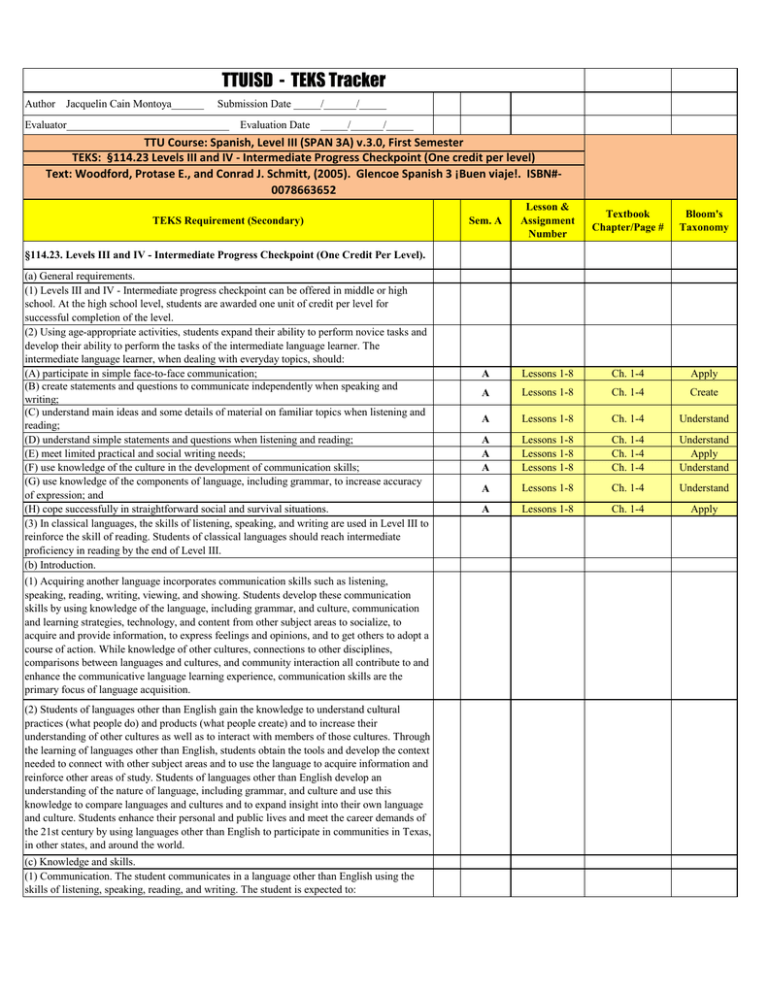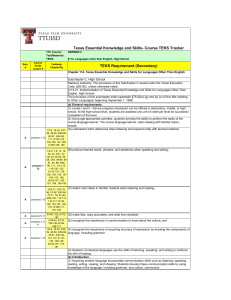Author Jacquelin Cain Montoya______ ... Evaluator______________________________ Evaluation Date _____/______/_____
advertisement

TTUISD - TEKS Tracker Author Jacquelin Cain Montoya______ Submission Date _____/______/_____ Evaluator______________________________ Evaluation Date _____/______/_____ TTU Course: Spanish, Level III (SPAN 3A) v.3.0, First Semester TEKS: §114.23 Levels III and IV ‐ Intermediate Progress Checkpoint (One credit per level) Text: Woodford, Protase E., and Conrad J. Schmitt, (2005). Glencoe Spanish 3 ¡Buen viaje!. ISBN#‐ 0078663652 TEKS Requirement (Secondary) Sem. A Lesson & Assignment Number Textbook Chapter/Page # Bloom's Taxonomy §114.23. Levels III and IV - Intermediate Progress Checkpoint (One Credit Per Level). (a) General requirements. (1) Levels III and IV - Intermediate progress checkpoint can be offered in middle or high school. At the high school level, students are awarded one unit of credit per level for successful completion of the level. (2) Using age-appropriate activities, students expand their ability to perform novice tasks and develop their ability to perform the tasks of the intermediate language learner. The intermediate language learner, when dealing with everyday topics, should: (A) participate in simple face-to-face communication; (B) create statements and questions to communicate independently when speaking and writing; (C) understand main ideas and some details of material on familiar topics when listening and reading; (D) understand simple statements and questions when listening and reading; (E) meet limited practical and social writing needs; (F) use knowledge of the culture in the development of communication skills; (G) use knowledge of the components of language, including grammar, to increase accuracy of expression; and (H) cope successfully in straightforward social and survival situations. (3) In classical languages, the skills of listening, speaking, and writing are used in Level III to reinforce the skill of reading. Students of classical languages should reach intermediate proficiency in reading by the end of Level III. (b) Introduction. (1) Acquiring another language incorporates communication skills such as listening, speaking, reading, writing, viewing, and showing. Students develop these communication skills by using knowledge of the language, including grammar, and culture, communication and learning strategies, technology, and content from other subject areas to socialize, to acquire and provide information, to express feelings and opinions, and to get others to adopt a course of action. While knowledge of other cultures, connections to other disciplines, comparisons between languages and cultures, and community interaction all contribute to and enhance the communicative language learning experience, communication skills are the primary focus of language acquisition. (2) Students of languages other than English gain the knowledge to understand cultural practices (what people do) and products (what people create) and to increase their understanding of other cultures as well as to interact with members of those cultures. Through the learning of languages other than English, students obtain the tools and develop the context needed to connect with other subject areas and to use the language to acquire information and reinforce other areas of study. Students of languages other than English develop an understanding of the nature of language, including grammar, and culture and use this knowledge to compare languages and cultures and to expand insight into their own language and culture. Students enhance their personal and public lives and meet the career demands of the 21st century by using languages other than English to participate in communities in Texas, in other states, and around the world. (c) Knowledge and skills. (1) Communication. The student communicates in a language other than English using the skills of listening, speaking, reading, and writing. The student is expected to: A Lessons 1-8 Ch. 1-4 Apply A Lessons 1-8 Ch. 1-4 Create A Lessons 1-8 Ch. 1-4 Understand A A A Lessons 1-8 Lessons 1-8 Lessons 1-8 Ch. 1-4 Ch. 1-4 Ch. 1-4 Understand Apply Understand A Lessons 1-8 Ch. 1-4 Understand A Lessons 1-8 Ch. 1-4 Apply TEKS Requirement (Secondary) (A) engage in oral and written exchanges to socialize, to provide and obtain information, to express preferences and feelings, and to satisfy basic needs; (B) interpret and demonstrate understanding of simple, straightforward, spoken and written language such as instructions, directions, announcements, reports, conversations, brief descriptions, and narrations; and (C) present information and convey short messages on everyday topics to listeners and readers. (2) Cultures. The student gains knowledge and understanding of other cultures. The student is expected to: (A) use the language at the intermediate proficiency level to demonstrate an understanding of the practices (what people do) and how they are related to the perspectives (how people perceive things) of the cultures studied; and (B) use the language at the intermediate proficiency level to demonstrate an understanding of the products (what people create) and how they are related to the perspectives (how people perceive things) of the cultures studied. (3) Connections. The student uses the language to make connections with other subject areas and to acquire information. The student is expected to: (A) use resources (that may include technology) in the language and cultures being studied at the intermediate proficiency level to gain access to information; and (B) use the language at the intermediate proficiency level to obtain, reinforce, or expand knowledge of other subject areas. (4) Comparisons. The student develops insight into the nature of language and culture by comparing the student's own language and culture to another. The student is expected to: (A) use the language at the intermediate proficiency level to demonstrate an understanding of the nature of language through comparisons of the student's own language and the language studied; (B) use the language at the intermediate proficiency level to demonstrate an understanding of the concept of culture through comparisons of the student's own culture and the cultures studied; and (C) use the language at the intermediate proficiency level to demonstrate an understanding of the influence of one language and culture on another. (5) Communities. The student participates in communities at home and around the world by using languages other than English. The student is expected to: (A) use the language at the intermediate proficiency level both within and beyond the school setting through activities such as participating in cultural events and using technology to communicate; and (B) show evidence of becoming a lifelong learner by using the language at the intermediate proficiency level for personal enrichment and career development. Source: The provisions of this §114.23 adopted to be effective September 1, 1998, 22 TexReg 4930. Sem. A Lesson & Assignment Number Textbook Chapter/Page # Bloom's Taxonomy A Lessons 1-8 Ch. 1-4 Apply A Lessons 1-8 Ch. 1-4 Analyze A Lessons 1-8 Ch. 1-4 Evaluate A Lessons 1-8 Ch. 1-4 Apply A Lessons 1-8 Ch. 1-4 Apply A Lessons 1-8 Ch. 1-4 Apply A Lessons 1-8 Ch. 1-4 Apply A Lessons 1-8 Ch. 1-4 Apply A Lessons 1-8 Ch. 1-4 Apply A Lessons 1-8 Ch. 1-4 Apply A Lessons 1-8 Ch. 1-4 Apply A Lessons 1-8 Ch. 1-4 Apply
